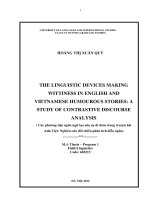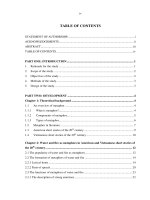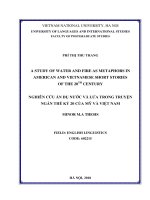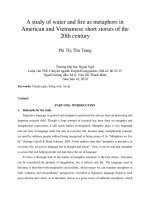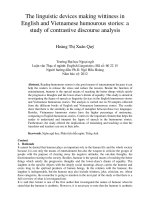A STUDY OF CHANGES IN THE VIETNAMESE TRANSLATIONS OF PREPOSITION PHRASES IN VANITY FAIR BY WILLIAM MAKEPEACE THACKERAY
Bạn đang xem bản rút gọn của tài liệu. Xem và tải ngay bản đầy đủ của tài liệu tại đây (703 KB, 48 trang )
<span class="text_page_counter">Trang 1</span><div class="page_container" data-page="1">
<b>QUANG NAM PROVINCIAL PEOPLE’S COMMITTEE QUANG NAM UNIVERSITY </b>
<b>DEPARTMENT OF FOREIGN LANGUAGE </b>
<b>TAN THI MY VUONG </b>
<i><b>A STUDY OF CHANGES IN THE VIETNAMESE </b></i>
<i><b>TRANSLATIONS OF PREPOSITION PHRASES IN VANITY FAIR BY WILLIAM MAKEPEACE THACKERAY </b></i>
<b>GRADUATION PAPER </b>
<b>Quang Nam, May 2018 </b>
</div><span class="text_page_counter">Trang 2</span><div class="page_container" data-page="2"><b>QUANG NAM PROVINCIAL PEOPLE’S COMMITTEE </b>
<b>QUANG NAM UNIVERSITY </b>
<b>DEPARTMENT OF FOREIGN LANGUAGE </b>
<b>GRADUATION PAPER </b>
<i><b>A STUDY OF CHANGES IN THE VIETNAMESE </b></i>
<i><b>TRANSLATIONS OF PREPOSITION PHRASES IN VANITY FAIR BY WILLIAM MAKEPEACE THACKERAY </b></i>
<b>RESEARCHER TAN THI MY VUONG STUDENT CODE: 2114020851 </b>
<b>MAJOR:ENGLISH </b>
<b>ACADEMIC COURSE: 2014-2018 SUPERVISOR: </b>
<b>DOAN PHAN ANH TRUC, M.A </b>
<b>Quang Nam, May 2018 </b>
</div><span class="text_page_counter">Trang 3</span><div class="page_container" data-page="3"><b>ACKNOWLEDGE </b>
Firstly and foremost, I would like to express my gratitude to all those who gave me the possibility to complete this study. I want to thank the Foreign Language Department of Quang Nam University for giving me the permission to commence this study in the first instance and to do the necessary research work.
I also would like to show my profound gratitude to my supervisor, Mrs. Doan Phan Anh Truc, M.A, whose reference materials, support, stimulation, suggestions and encouragement help me in all stages of this research for and writing of this study.
Besides, I am deeply indebted to my beloved family for their wholehearted support and encouragement. I also would like to dedicate my special thanks to my classmates from English class DT14TAN02 , who have supported, cooperated and provided me with valuable suggestions.
Finally, I cannot fully express my gratitude to all people whose direct and indirect support assisted me to accomplish my study in time.
</div><span class="text_page_counter">Trang 4</span><div class="page_container" data-page="4"><b>ABSTRACT </b>
The research paper examines some types of translation shifts : class shifts, unit/ rank shifts, structure shifts on the basic of 200 samples taken from " Vanity Fair". We will discuss and point out translation shifts in Vietnamese translations as well as give recommendation to employ translation shifts for translation skill. The study is to help learners realize how preposition phrases of place are translated into Vietnamese so that they would be able to use shifts effectively.
</div><span class="text_page_counter">Trang 5</span><div class="page_container" data-page="5"><b>ABBREVIATIONS </b>
NP: Noun phrase VP: Verb phrase AP: Adjective phrase PP: Preposition phrase P: Preposition
N: Noun V: Verb
SL: Source language TL: Target language
</div><span class="text_page_counter">Trang 6</span><div class="page_container" data-page="6"><b>LIST OF THE TABLES AND FIGURES </b>
<i><b>Table 2.1. The word order of noun phrases in Vietnamese. Table 2.2. The word order of verb phrases in Vietnamese. Table 2.3. The word order of adjective phrases. </b></i>
<i><b>Table 4.1. Distribution of structure shifts in English </b></i>
<i><b>Table 4.2. The changes of preposition phrases when preposition phrases </b></i>
<i>have function as post modifiers in verb phrases.</i>
<i><b>Table 4.3.Occurences of structure shifts of preposition phrases of place </b></i>
<i>when preposition phrases play the roles as post modifiers in noun phrases. </i>
<i><b>Table 4.4. Structure shifts used in the novel " Vanity Fair" </b></i>
<i><b>Figure 4.1. Structure shifts of preposition phrases of place when </b></i>
<i>preposition phrase of place play the roles as post modifiers in verb phrases. </i>
<i><b>Figure4. 2. Structure shifts of preposition phrases of place when </b></i>
<b>preposition phrases play the role as post modifiers in noun phrases. </b>
</div><span class="text_page_counter">Trang 7</span><div class="page_container" data-page="7"><b>1.2. Significance of the Study ... 1</b>
<b>1.3. Scope of the Study ... 2</b>
<b>1.4. Aims and Objectives of the Study ... 2</b>
<i><b>1.4.1. Aims of the Study ... 2</b></i>
<i><b>1.4.2. Objectives of the Study ... 2</b></i>
<i><b>2.2.2. Preposition phrases in English ... 10</b></i>
<i><b>2.2.2.1. Concept of Preposition phrases of Place ... 10</b></i>
<i><b>2.2.2.2. Types of preposition phrases of place ... 11</b></i>
</div><span class="text_page_counter">Trang 8</span><div class="page_container" data-page="8"><i><b>4.1.2.Preposition phrases have function as post modifiers in noun phrases ... 25</b></i>
<b>4.2. The frequency of Structure shifts in the Vietnamese translations of Preposition phrase of Place ... 29</b>
<b>4.3. Discussions of the Findings ... 30</b>
<b>5.2.1. Implication for translation learning ... 34</b>
<b>5.2.2. Implications for translation teaching ... 34</b>
<b>5.3. Limitations ... 35</b>
<b>5.4. Recommendations ... 35</b>
<b>5.4.1. Recommendation for teaching ... 35</b>
<b>5.4.2. Recommendation for learning ... 36</b>
<b>5.4.3. Recommendation for further study ... 36</b>
<b>REFERENCES ... 37</b>
</div><span class="text_page_counter">Trang 9</span><div class="page_container" data-page="9"><b>CHAPTER 1 INTRODUCTION 1.1. Rationale </b>
Translation can be considered an indispensable part in the fields of not only literature, culture and religion but also commercial advertisements, popular entertainment, public administration, and education, etc. Translation plays a key role in the universalization of human knowledge. It helps improve international understanding, socio-cultural awareness, professional communicative activities, implements of technologies, and so on.
Translation is an core subject for the English major students at Quang Nam University. It exploits our knowledge on different fields so we are required to equip not only specified knowledge and vocabulary but also translation theory. For example, learners need to know how changes occur when they translate a noun phrase, a verb phrase or a preposition phrase into English. To do this, it is obligatory for us to grasp the theory of shifts in translation.
Translation is a multi- skilled process so it causes a lot of difficulties for leaners in choosing correct methods and using equivalents in the target text. Especially it is also difficult for learners to translate preposition phrases of place because they are not confident to use necessary changes instead of using the word-for-word technique very often. Specifically learners do not understand of shifts in translation so it is not easy for them to apply them to target translated versions. As a result, they can mistranslate or convey wrong meanings.
Up to now, there has not been any study of shifts in the Vietnamese translations of English preposition phrases of place. Therefore, we choose the
<i>topic ― A study of changes in the Vietnamese translation of preposition phrases in Vanity Fair by William Makepeace Thackeray”. We hope that our research </i>
paper will make a contribution to the learners' improvement of translation.
<b>1.2. Significance of the Study </b>
The researchers hope that this study, to some extent, can be useful for English learners in general and translators in particular to identify changes of
</div><span class="text_page_counter">Trang 10</span><div class="page_container" data-page="10">preposition phrases of place in Vietnamese translations. Moreover, it helps reduce the ambiguity of shifts for English learners as well as reduce mistakes in translation. Especially, the English major students can get a lot of benefits from this study in order to partly improve their translation competence. In general, the findings of the study can be a potential source for using and translating preposition phrases from English to Vietnamese effectively.
<b>1.3. Scope of the Study </b>
Due to limitation of time, space, knowledge and experience in this paper we just focus on preposition phrases of place and changes in the Vietnamese translation of preposition phrases of place mentioned in Vanity Fair by William Makepeace Thackeray.
<b>1.4. Aims and Objectives of the Study </b>
<i><b>1.4.1. Aims of the Study </b></i>
This study aims at helping translators be able to understand clearly about changes in structure when translating English preposition phrases into Vietnamese. Furthermore, the aim is to help English learners translate preposition phrases of place more accurately and partly improve translation skill.
<i><b>1.4.2. Objectives of the Study </b></i>
This study is intended to:
Identify changes in the Vietnamese translation of preposition phrases of place showed in Vanity Fair by William Makepeace Thackeray.
Give some effective suggestions for translating preposition phrases of place as well as some learning ways to enhance learners’ translation skills.
<i><b>1.5. Research Questions </b></i>
The study seeks answers to the retailing research questions:
1. What are the changes in Vietnamese translations of preposition phrases of place in Vanity Fair by William Makepeace Thackeray?
What are some implications of the research on the learning and teaching of translation shifts of preposition phrases of place?
</div><span class="text_page_counter">Trang 11</span><div class="page_container" data-page="11">What are some suggestions that learners can apply to improve translation skill?
<b>1.6. Organization of the Study. </b>
The research includes 5 chapters as below:
<b>Chapter 1 Introduction </b>
The chapter is the introduction of our study including rationale, aims and objective of the study, the scope of the study and organization of the study.
<b>Chapter 2 Literature Review </b>
The chapter consists of two parts
-The first part is a review of previous research related to the paper. -The second part provides the theoretical background for the study. It also involves key terms of the study
<b>Chapter 3 Method and Procedure </b>
The chapter mentions that the research methodology carried out in the research involving research design, data collection and data analysis and validity and reliability.
<b>Chapter 4 Finding and Discussion </b>
The chapter presents the results and a discussion of the findings of the analysis conducted in exploring translation shifts in the Vietnamese translation of preposition phrases of place in novel "Vanity Fair" by William Makepeace Thackeray.
<b>Chapter 5: Conclusion and Implications </b>
The chapter summarizes and concludes what has been done in the research, implications of the study points and limitations of the study as well as some
<b>recommendations for further researches. </b>
</div><span class="text_page_counter">Trang 12</span><div class="page_container" data-page="12"><b>and unit/rank shifts and structure shifts. </b>
</div><span class="text_page_counter">Trang 13</span><div class="page_container" data-page="13">As for preposition study, there have been many works on preposition phrases in general. Quirk et al (1972) shows that Preposition phrase of Place are typical either adjuncts (relating an even or state of affairs to a location) or post - modifiers ( relating some object to a location). According to Collins (2001), adjuncts consisting of a preposition and a noun group, such as ―in a box‖ and ― to the station‖, are called preposition phrases. Tra (2005) studies English preposition of place and analysis of errors made by secondary school students and ― a study on preposition phrase of time in English by Trang (2009)‖ and Dieu (2010) mentions preposition of direction and some errors made by Vietnamese learners.
Although many studies of preposition phrases in translation have been carried out, there have been few studies of changes in Vietnamese translations of English preposition phrases. A study of changes in the Vietnamese translations of preposition phrases in Vanity Fair by William Makepeace Thackeray is completely new. The study is in hope of putting some useful practical suggestions for teaching and learning preposition phrases translation.
</div><span class="text_page_counter">Trang 14</span><div class="page_container" data-page="14">Bell (1991), translation is the transformation of a text originally in one language into an equivalent in the content of the message and the formal features and the roles of the original. Peter Newmark (1991) mentions that translation includes both written and spoken language which are two important means of communication. Peter Newmark (1991, p.7) states that " translation is a craft consisting of the attempt to replace the written message and statement in one language by the same message and statement in another language". Bui Tien Bao (1997) looks at translation is rendering a written text into another language in a way that the author intended the text. As for Houbert (1998:1), translation is understood as the process where by a message expressed in a specific source language is linguistically transformed in order to be understood by readers of the target language.
<i>2.2.1.2. Main translation methods </i>
According to Peter Newmark, (1988, p.45- 47), there are some methods used in translation as follow:
a. Word - for - word
This is often demonstrated as interlinear translation, with the TL immediately below the SL words. The SL word order is preserved and the words translated singly by their most common meanings, out of context. Cultural words are translated literally. The main use of word - for - word translation is either to understand the mechanics of the SL or to construe a difficult text as a pre-translation process.
b. Literal translation
The SL construction are converted to their nearest TL equivalents but the lexical words are again translated singly, out of context. As a pre- translation process, this indicates the problems to be solved.
c. Faithful translation
A faithful translation attempts to reproduce the precise contextual meaning of the original within the constraints of the TL grammatical structures. It " transfers" cultural words and preserves the degrees of grammatical and lexical " abnormality" ( deviation from SL norm) in the translation. It attempts to be completely faithful to the intention and the text- realization of the SL writer.
</div><span class="text_page_counter">Trang 15</span><div class="page_container" data-page="15">d. Semantic translation
Semantic translation differs from " faithful translation" only in as far as it must take more account of the aesthetic value ( that is, the beautiful and natural sound) of the SL text, compromising on " meaning" where appropriate so that no assonance, word- play or repetition jars in the finished version. Further, it may translate less important cultural words by culturally neutral third of functional terms but not by cultural equivalents and it make other small concessions to readership.
In semantic translation, translators have to be legal to the author and respect the context. Therefore, semantic translation is objective. Peter Newmark (1980, p.63) proposes interlinear translation when considering semantic translation: " the primary senses of all words in the original are translated as though out of context , and the word- order of the original is retained. The main purpose is either to understand the mechanics of the SL or to constitute a pre- translation procedure for a complicated SL text". Since the form of the text is important, semantic translation may well not read like an original TL text.
e. Adaptation
This is a " freest" form of translation. It is used mainly for plays ( comedies) and poetry; the themes, characters, plots are usually preserved, the SL culture converted to the TL culture and the text rewritten by an established dramatist or poet has produced many poor adaptations, but other adaptations have " rescued" period plays.
f. Free translation
Free translation produces the matter without the manner, or the content without the form of the original. Usually, it is a paraphrase much longer than the original, a so- called " intralingual translation ", often prolix and pretentious, and not translation at all.
g. Idiomatic translation
Idiomatic translation reproduces the " message" of the original but tends to distort nuances of meaning by preferring colloquialism ad idioms where these do not exist in the original.
h. Communicative translation
Communicative translation attempts to render the exact contextual meaning of the original in such a way that both content and language are readily acceptable and comprehensible to the readership.
In communicative translation, translators have the rights to correct or improve their logic, to replace clumsy with elegant, or at least functional,
</div><span class="text_page_counter">Trang 16</span><div class="page_container" data-page="16">syntactic structures, to remove obscurities, to eliminate repetition and tautology, to exclude the less likely interpretations of an ambiguity, to modify and clarify jargon (i.e. reduce loose generic terms to rather more concrete components), and to norminate bizarreries of idiolect ( i.e. wayward uses of language). Further, one has the rights to concrete mistakes of fact and slips, normally stating what one has done in a foot note.
<i>2.2.1.3. Translation shift Concept of translation shift </i>
Catford (1965:73) defines translation shift as a departures from formal correspondence in the process of going from source language ( SL) to target language (TL). Items which can be shifted are grammar as Newmark (1988:55) states shifts is translation procedure involving a change in grammar from SL to TL, and word- class as Vinay and Darbelnet (1958:64) states transposition is the replacement of one word- class by another without changing the meaning of the message. Newmark (1988:85) states at least four reasons behind the occurrence of shifts. The first one is when SL and TL have different language systems so the shifts occur automatically and translators have no options but to undergo those shifts. Another reason is when the grammatical structure of SL do not exist in TL. Further, shifts also occur where literal translation is grammatically possible but may not accord with natural usage in the TL so it is the matter of naturalness between SL and TL. The last, shifts occur to replace virtual lexical gap by grammatical structure.
<i>Types of translation shifts </i>
Catford (1965: 73) divides into two major types namely level shifts and category shifts. The category shifts are divided into structure shifts, class shifts,
<i>rand/unit shifts and intra - system shifts. </i>
a. Level shifts
Level shifts occur when an item at one linguistic level in SL has its translation equivalent at different level in TL ( Catford: 73). The only possible level shift in translation is the shift from grammar to lexis and vice versa as in
</div><span class="text_page_counter">Trang 17</span><div class="page_container" data-page="17">the translation between English ― this text is intended for…‖ to French ― Le present Manuels’ adresse a…‖. from the example above, level shift occurs when English ― this‖ as a term in grammatical system of deictic is translated to French ― le present‖ as a modifier consisting an article + a lexical adjective.
Class shift
Class shift occurs when the translation equivalent of a SL item is a member of a different class from the original item. An example is given by Catford (1965:79) clearly shows a change of class from English phrase ― a white house‖ to French phrase ― Une maison blanche‖ where the English adjective ― white‖ as a modifier has its equivalence in French adjective ― blanche‖ as a qualifier although both of them are adjectives, they possess different functions as a modifier in English and as a qualifier in French. A change of class also occurs when an English clause ―they insist on higher wages‖ is translated into an Indonesian clause ― mereka menuntut kenaikan gaji‖. The example shows that
</div><span class="text_page_counter">Trang 18</span><div class="page_container" data-page="18">the English adjective of comparative ―higher‖ changes into Indonesian noun ―kenaikan‖.
Rank/ Unit shift
Unit/rank shift is the changes of rank; that is, departures from formal correspondence in which the translation equivalent of a unit at one rank in the source language is a unit at a different rank in the target language. Chi (2014) determines two kind of rank/ unit shifts: up - rank shifts are the addition of elements to the target text which are implicit from the original text. Down - rank shifts are the reject components from the target text.
Intra- System shifts
Intra- System shift is departures from formal correspondence where (a term operating in) one system in the source language (SL) has its translation equivalent ( a term operating in) a different non- corresponding system in the target language (TL), the shift occurs internally within a system. Vinay and Darbelnet in Carford (1965:80) give examples of the system related to the singular and plural form of words between English and French. An English singular word ―advice‖ has translation equivalent French plural word ― des concil‖ and vice versa, a French singular word ― le pantalon‖ has translation equivalent an English plural words ― trousers‖.
<i><b>2.2.2. Preposition phrases in English </b></i>
A preposition phrase (PP) is a group of words consisting of a preposition as the head and followed by its complement as a noun phrase.
<i>There are many different preposition phrase such as: preposition phrases of place, preposition phrases of time, prepositions phrases of cause and purpose….. </i>
<b>Preposition phrases of place: the players were practicing on the field Preposition phrases of time: we camped there in the summer </b>
<b>Preposition phrases of cause and purpose: the survivors were weak from exposure and lack of food. </b>
<b>He will do anything for money </b>
Due to limitation the time, we only concentrate to study Preposition phrases of Place.
<i>2.2.2.1. Concept of Preposition phrases of Place </i>
Quirk et al (1972) shows that preposition phrases of place are typical either adjuncts (relating an even or state of affairs to a location) or post – modifiers
</div><span class="text_page_counter">Trang 19</span><div class="page_container" data-page="19">(relating some object to a location); they may also act as obligatory ―predicative‖ adjuncts following the verb Be, as in Maggy is in the kitchen. Moreover, Quirk et al (1972) divides preposition phrases into several types:
<i>simple position and destination, negative position, dimension- types, relative position, passage, movement with reference to a directional path, orientation, resultative meaning, pervasive meaning, seven senses of over, verbs incorporating prepositional meaning and metaphorical or abstract use of place prepositions. </i>
According to Collins(2001), adjuncts consisting of a preposition and a noun group, such as ―in a box‖ and ― to the station‖, are called preposition phrases. Collins also divided preposition phrases of place into many kinds, but it is not clear. So we choose the theoretical background framework by Quirk et al (1972)for our analysis.
<i> 2.2.2.2. Types of preposition phrases of place </i>
Quirk et al ( 1972) shows that preposition phrase of place have many different sub - type such as : simple position and destination, negative position, dimension –types, relative position, relative destination, passage, movement with reference to a directional path, orientation, resultative meaning, pervasive meaning, verbs incorporating prepositional meaning and metaphorical or abstract use of place prepositions.
<i><b>Some prepositions of place: simple position and destination: abroad, </b></i>
<i>about, above, across, against, ahead of, all over, along, alongside, amidst, among, around, astride, at, away from, before, behind, below, beneath, beside, between, beyond, by, close by, close to, down, in, in between, in front of, inside, near, near to, next to, off, on top of, opposite, out of, outside, past, through, </i>
<i><b>under, underneath, up, upon, with, within and negative position: away from, off, out of and dimension types: at, on, in and relative position: by, over, </b></i>
<i>under, above, over, on top of, behind, below, under, underneath and beneath </i>
<i><b>and relative destination: by, over, under, across, through, past and movement with reference to a directional path: up, down, along, across and round and orientation: beyond, over, past and through. </b></i>
The structure for a preposition phrases of place as follows: ( Deg) + preposition place ( head) + ( object)
</div><span class="text_page_counter">Trang 20</span><div class="page_container" data-page="20"><b> The head </b>
The most important component of preposition phrases of place is the head. It is the center of attraction of the preposition phrases, which must be a preposition of place.
The head determines concord with the portion of the sentences and controls the overall meaning of preposition phrases. All the other components in the preposition phrases of place modify the head, for example: in the garden; on the floor; at the window….
<i><b> A noun phrase: the bus is in front of the car. </b></i>
<i><b> A pronoun: he has a hundred people working under him A noun: in out of danger, in difficulties </b></i>
<i><b> An ing clause: a letter from browning to his wife. </b></i>
</div><span class="text_page_counter">Trang 21</span><div class="page_container" data-page="21"><i>a. Noun phrases </i>
<i> Definition </i>
Thuat, Ha and Quynh (2001) have defined a Vietnamese noun phrases as a free combination of a noun nucleus and one or more than one subordinate elements which can be front elements (that stand before the nucleus noun) or back elements (that stand after the nucleus noun)
For examples: gian phòng khách Structures
According to Tuong (2004), Vietnamese noun phrases elements include pre- nominal modifiers (quantifiers, articles, numerals, the particle " cái", classifiers, measure phrase) and post - nominal modifiers (noun adjuncts, adjective phrases, preposition phrases, relative clauses, demonstrative, and possessives), in addition to the head noun.
Pre -nominal modifier
Classifier Noun
Trong phòng riêng
của bà quản gia
For examples: trong phòng riêng, bãi cỏ,phủ tống trấn…
<b> Pre - nominal modifier </b>
Sometimes, articles is one of cases of pre-nominal modifier. Most researchers argue that there are no lexical articles. According to Nguyen (1975), " một, những, các" are articles in Vietnamese. Articles must precede the head noun.
<i> For example: một bãi cỏ xanh </i>
</div><span class="text_page_counter">Trang 22</span><div class="page_container" data-page="22">
<b> Post- nominal modifiers </b>
The relation between the head noun and post - nominal modifiers favors to the syntax relation. A noun can have any of the following post - nominal modifiers:
<i> Noun adjuncts, for example: phủ Tổng trấn Madra. Adjective, for example: một bãi cỏ xanh. </i>
Possessives, for example: trong phòng riêng của bà quản gia. Functions
Noun phrases in Vietnamese can function as subjects, predicates, noun modifiers, objects and adverbials
b. Verb phrases Definition
As for Bui Minh Toan and Nguyen Thi Luong (2004), a verb phrase is a syntactic unit consisting of an auxiliary (helping) verb preceding the main verb. It often contains a head verb, complements, objects, and modifiers as its dependents.
Structure
According to Bui Minh Toan and Nguyen Thi Luong (2004), Verb phrase in Vietnamese elements include pre- nominal modifiers and post - nominal modifiers, in addition to the head Verb.
<i><b>Table 2.2. The word order of Verb phrase in Vietnames. </b></i>
<b> The head </b>
The central element is divided into five groups:
*Group 1: These verbs do not stand alone, they are usually followed by other verbs.
There are many different types:
-Modal verbs: phải, nên, cần,dám, có thể, sẽ, định... For example: Nó định nghỉ học
Định is the central element
-Passive: bị, được, mắc, phải, chịu...
</div><span class="text_page_counter">Trang 23</span><div class="page_container" data-page="23">For example: Anh ta bị thầy phạt Bị is the central element
-Verb phrases with two parallely existential actions: đứng khóc, nằm ngủ, đi học, đi chơi, ngồi nghe...
For example: Anh ta đi chơi phố Đi chơi is the central element
*Group 2: Verbs always go with additive elements
-Verbs with sense of moving: mở, dậy, kéo, đến, xuống, đi, bưng.... For example: Anh ta đi ra
Đi is the central element and ra is the additive element
-Verbs with sense of achieving results: hiểu ra, đọc xong, bay mất, nhặt lấy, thu được, tìm thấy.
For example: Nó để bay mất con gà
Bay is the central element and mất is the additive element
-Verbs with sense of affecting two objects: cho, tặng, biếu, lấy, mượn, vay, cầm, xin, gửi..
For example: My tặng Thọ hai cuốn truyện Central element: tặng
Object 1: Thọ
Object 2: hai cuốn truyện
-Verbs with sense of governing two objects and objects’ activities are actions of order: bảo, sai, bắt, cho phép, buộc, khiến...
For example: Thầy giáo bảo Nam lên bảng Bảo is the central element
-Verbs with sense of governing an object and connecting with another object: trộn, pha, nối, chắp, hòa...
For example: Trộn bột với đường Trộn is the central element
Bột and đường are objects
- Verbs with sense of governing additive element and having the structure A is B and meanings of evaluating: coi, bầu, lấy, xem, cử...
For example: Coi anh là bạn
</div><span class="text_page_counter">Trang 24</span><div class="page_container" data-page="24">Bầu ông Thao là chủ tịch
*Group 3: combination of verbs: chạy ra chạy vào, bàn qua bàn lại, đi ngược về xuôi, trèo lên tụt xuống...
*Group 4: Verbs with sense of the state or a period of an action: bắt đầu học, tiếp tục đi, thơi nói, hết chạy, ngừng học....
*Group 5:Verbs with sense of mood: lo lắng, bồn chồn, thoi thóp, thấp thỏm...
For example: Người mẹ đang lo lắng về đứa con của mình
<b> Pre-additive element </b>
We can divide pre-additive element into the following :
*Words with sense of continuing of activity or state: đều, cũng, vẫn, cứ, lại, mãi, tiếp tục...
For example: Họ vẫn ngồi im.
Vẫn is pre-additive element of the verb phrase ―vẫn ngồi‖
*Words indicate the time of action or state: từng, đã, vừa, mới, đang, sẽ... For example: Em sẽ kể anh nghe
Chuyện con thuyền và biển
Sẽ is the pre-additive element of the verb phrase ―sẽ kể‖
*Words indicate the frequency: thường, hay, năng, ít, đơi khi, thỉnh thoảng...
For example: Anh ta thỉnh thoảngghé qua chỗ tôi.
Thỉnh thoảng is the pre-additive element of the verb phrase ―thỉnh thoảng ghé‖
*Words indicate the negation or affirmation: không, chưa, chẳng, chỉ... For example: Em ở đây, đời chẳng còn đáng ngại
Em ở đây, bàn tay tin cậy Chẳng is the pre-additive element
*Words indicate the level: rất, hơi, khi, quá... For example: Rất đẹp hình anh lúc nắng chiều Rất is the pre-additive element
*Words indicate the order: hãy, đừng, chớ...
For example: Chớ nói cười, hãy lắng nghe xem đã
Chớ , hãy is the pre-additive element of the verb phrase ―Chớ nói cười, hãy lắng nghe‖
*Words indicate the limitation: chỉ
</div>


